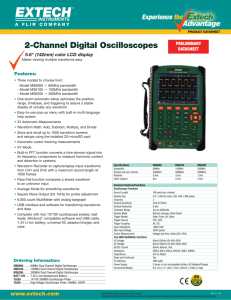Department of Electrical and Computer Engineering Laboratory
advertisement
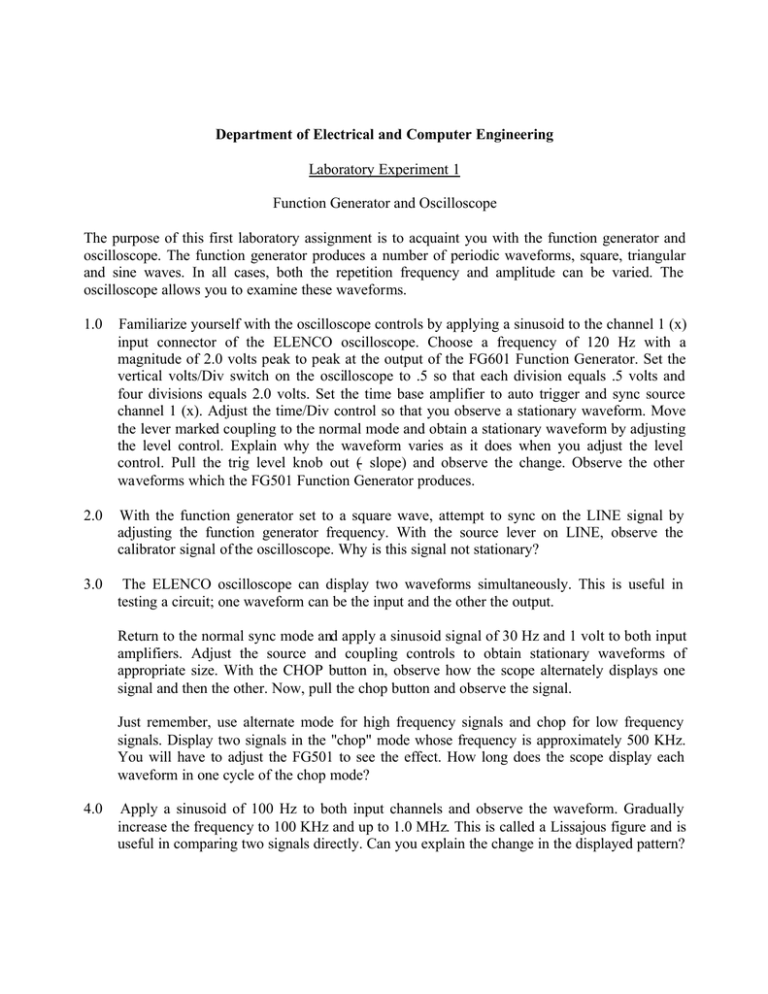
Department of Electrical and Computer Engineering Laboratory Experiment 1 Function Generator and Oscilloscope The purpose of this first laboratory assignment is to acquaint you with the function generator and oscilloscope. The function generator produces a number of periodic waveforms, square, triangular and sine waves. In all cases, both the repetition frequency and amplitude can be varied. The oscilloscope allows you to examine these waveforms. 1.0 Familiarize yourself with the oscilloscope controls by applying a sinusoid to the channel 1 (x) input connector of the ELENCO oscilloscope. Choose a frequency of 120 Hz with a magnitude of 2.0 volts peak to peak at the output of the FG601 Function Generator. Set the vertical volts/Div switch on the oscilloscope to .5 so that each division equals .5 volts and four divisions equals 2.0 volts. Set the time base amplifier to auto trigger and sync source channel 1 (x). Adjust the time/Div control so that you observe a stationary waveform. Move the lever marked coupling to the normal mode and obtain a stationary waveform by adjusting the level control. Explain why the waveform varies as it does when you adjust the level control. Pull the trig level knob out (- slope) and observe the change. Observe the other waveforms which the FG501 Function Generator produces. 2.0 With the function generator set to a square wave, attempt to sync on the LINE signal by adjusting the function generator frequency. With the source lever on LINE, observe the calibrator signal of the oscilloscope. Why is this signal not stationary? 3.0 The ELENCO oscilloscope can display two waveforms simultaneously. This is useful in testing a circuit; one waveform can be the input and the other the output. Return to the normal sync mode and apply a sinusoid signal of 30 Hz and 1 volt to both input amplifiers. Adjust the source and coupling controls to obtain stationary waveforms of appropriate size. With the CHOP button in, observe how the scope alternately displays one signal and then the other. Now, pull the chop button and observe the signal. Just remember, use alternate mode for high frequency signals and chop for low frequency signals. Display two signals in the "chop" mode whose frequency is approximately 500 KHz. You will have to adjust the FG501 to see the effect. How long does the scope display each waveform in one cycle of the chop mode? 4.0 Apply a sinusoid of 100 Hz to both input channels and observe the waveform. Gradually increase the frequency to 100 KHz and up to 1.0 MHz. This is called a Lissajous figure and is useful in comparing two signals directly. Can you explain the change in the displayed pattern? Lab Report Requirements This document consists of a series of numbered items, each of which asks you to report observations made during the lab session and to answer questions about these observations. Your lab report should consist of written responses to each of the items. No introduction, procedure, etc. are needed. Before leaving the lab session, make sure that you have recorded all the information necessary to prepare your lab report. 1.1 Describe the effect on the displayed calibrator waveform in NORMAL triggering mode as the LEVEL knob is varied from maximum negative to maximum positive. What is triggering and what is the function of the LEVEL knob? 1.2 Describe the change in the displayed waveform when the (-) SLOPE knob is pulled out. Why does this change occur? 2.1 Describe in detail the effect on the displayed waveform as the frequency of the function generator is varied over the range you choose. Fully explain the reason for this behavior in terms of line triggering. 2.2 Why is the display of the calibrator signal not stationary when using the line-triggering mode? 3.1 Which mode, CHOP or ALT, is preferable for low frequency signals, and which for high frequency signals? Why? 3.2 How long does the scope display each waveform in one cycle of the CHOP mode? 4.1 Why does the high frequency attenuation affect only the magnitude of a sine wave, but alter the shape of a square wave? What would be the effect on other waveforms, like triangle waves? 5.1 Although the two vertical input amplifiers are identical in frequency bandwidth (40 MHz), they share the same MAIN vertical amplifier. When using the "xy" mode of operation, to display Lissajous figures, the main vertical and main horizontal output amplifiers are used in the oscilloscope. Describe the shape of the Lissajous figures at I KHz and I MHz. Why are they different? 5.2 Describe and explain the variation in the Lissajous figure at 100 KHz, as the magnitude of the input signal is adjusted from minimum to maximum. Northwestern University Depart ment of Electrical and Computer Engineering Operating Instructions for the Elenco S-1340 Oscilloscope Introduction The heart of every oscilloscope is the cathode ray tube (CRT). Internally, the CRT has 3 main elements, an electron gun, a phosphor-coated screen, and two sets of deflection plates. See figure 1. The basic operation is as follows. The electron gun emits a beam of electrons which causes the phosphor screen to glow at the point of impact. The brightness depends on the density and velocity of the electrons, and is varied by the intensity control. If a voltage is then applied across one set of deflection plates, the beam will bend toward the positive plate and away from the negative plate, causing the point of light to move. One set of plates is used to control the horizontal movement of the beam and the other set of plates to control the vertical movement. By property controlling the voltages across both sets simultaneously, any type of picture can be "painted" on the screen. Most often a scope is used to plot circuit voltage waveforms as they change with time. In this case, the horizontal axis of the screen face represents time and the vertical axis represents the voltage under test. Thus, the test signal would be applied across the vertical plates (note that it might be necessary to either amplify the signal if it is too small or attenuate it if it is too large). A signal proportional to time is applied to the horizontal plates. This signal must be generated by the scope itself, and the section that does this is called the timebase. A typical timebase signal is shown in figure 2. Figure 2 If the waveform under test only occurs once, the scope can only plot it once, and this will probably happen so fast that we won't be able to see it. A photograph must be taken of it or it must be displayed on an analog or digital storage scope. More commonly, however, the waveform will be periodic (i.e., repeat itself regularly) and we can simply make the scope keep tracing the plot on top of itself. Since the eye tends to retain the image from one trace to the next, it will appear as a steady picture. Figure 2 shows the repetitive time base signal required for this. During the trace portion of the cycle, the beam will move linearly across the screen. During the retrace, the beam instantly returns to the starting (le ft) edge of the screen and remains ready for the next trace. Note that the scope must be set to trace at exactly the same rate as the waveform repeats or the picture will appear to move across the screen. This is a common problem with the older scopes, but most of the newer, more expensive scopes have a feature called triggering that eliminates this annoyance. OPERATION CONTROLS AND CONNECTORS Channel A (CHA) Controls Refer to Figure 1 and Figure 2 as you read the following paragraphs. The number at the beginning of each paragraph corresponds to the circled number on the illustrations. 11. POSITION - Positions the CHA trace vertically on the CRT screen. NOTE: This control is inoperative for the X-Y mode. General 1. Line Voltage and Fuse label - Lists the acceptable voltage range and fuse rating for each of die four ways that you can install the line voltage selector plug. 2. AC line voltage selector plug and fuse – Allows you to match your AC line voltage to the oscilloscope's power transformer by aligning the arrowhead on the rear panel with the appropriate voltage (110, 125, 220, or 240) on the selector plug. The fuse is on the inside of the selector plug. CAUTION: For continued safety, replace the fuse with a properly rated part. Refer to the rear panel and the Parts List. 3. AC input socket - Receptacle for ft 3-wire AC line cord. 4. POWER - Turns the Oscilloscope on and off. 5. "ON" LED - Lights when the POWER switch is pushed "ON" 6. INTENSITY - Clockwise rotation increases the brightness of the display. Adjust the brightness for your lighting conditions. Refocusing may be necessary when the intensity is changed. CAUTION: Do not allow a bright spot to remain on the screen; it could damage the CRT. 7. TRACE ROT - This is a seldom-used control that aligns the trace to the horizontal graticule lines. Readjustment may be required in the presence of magnetic materials, electromagnetic fields, or after moving the Oscilloscope to a new location. 8. FOCUS - Varies the size of the electron beam striking the screen. Adjust for the sharpest display. 9. GND - Provides a chassis ground that is connected to the 3-wire AC line cord (earth) ground. 10. CAL 2Vp -p - Provides a 1 kHz square wave signal useful for frequency compensation of probes, checking amplifier gain, etc. PULL ALT TRIG - For dual trace signals, selects the triggering mode in which each sweep alternates between channel A (CHA) and channel B (CHB) signals as separate triggering sources. 12. 1 MΩ 25 pF - This BNC connector is the CHA input. It is also the X (horizontal) input during X-Y mode operation. 13. VOLTS/DIV - Each position of this attenuator switch is marked with a number that indicates the peak-to-peak input voltage required to produce a peakto-peak deflection of one major division (1 cm) on the screen's graticule when the VAR PULL 5X MAG control is set to its CAL'D (fully clockwise) position and pushed in. 14. VAR PULL X5 MAG - This control is normally set to its CAL'D position (fully clockwise), where the VOLTS/DIV switch positions are calibrated. The vertical gain decreases as the control is turned counterclockwise, permitting the size of the vertical pattern to be adjusted in a continuous manner between the selected range and the next higher range. * When this knob is pulled out the vertical amplifier sensitivity is increased by a factor of five. * 15. AC-GND-DC - This switch has three positions: AC: The input signal is capacitively coupled to the vertical amplifier and any DC component is blocked. The low-frequency limit is about 10 Hz (at -3 dB). GND: Disconnects (opens) the input circuit and grounds the vertical amplifier input. Use this position when you wish to set the trace to a desired reference baseline without disconnecting the input signal. DC: Both the DC and AC components of the input signal are applied to the vertical amplifier input. Channel B (CHB) Controls 16. POSITION - Positions the CHB trace vertically on the CRT screen. It is also the Y (vertical) position control in the X-Y mode. PULL INV - When the POSITION control is pulled out, the CHB trace (AC plus DC) is inverted. 17. 1 MΩ 25 pF - This BNC connector is the CHB input. It is also the Y (vertical) input during X-Y operation. 18. VOLTS/DIV - Each position of this attenuator switch is marked with a number that indicates the peak-to-peak input voltage required to produce a peakto-peak deflection of one major division (1 cm) on do screen's graticule when the VAR PULL X5 MAG control is set to its CAL'D position (fully clockwise) and pushed in. 19. VAR PULL X5 MAG - This control is normally set to its CAL'D position (fully clockwise), where the VOLTS/DIV switch positions are calibrated. The vertical gain decreases as the control is turned counterclockwise, permitting the size of the vertical pattern to be adjusted in a continuous manner between the selected range and the next higher range. * When this knob is pulled out, the vertical amplifier sensitivity is increased by a factor of five. * 20. AC-GND-DC - This switch has three positions: AC: The input signal is capacitively coupled to the vertical amplifier and any DC comp onent is blocked. The low-frequency limit is about 10 Hz (at -3 dB). GND: Disconnects (opens) the input circuit and grounds the vertical amplifier input. Use this position when you wish to set the trace to a desired reference baseline without disconnecting the input signal. DC: Both the DC and AC components of the input signal are applied to the vertical amplifier input. Both Channels Control 21. VERT MODE-This switch has four positions: CHA: Displays the Channel A trace only. CHB: Displays the Channel B trace only. DUAL: Displays both the CHA and CHB traces. The traces are normally alternating; that is, CHB is swept at the end of the CHA sweep and vice versa. You can select a chopping mode by pulling the HOLDOFF control. In this mode, the trace is quickly switched between the CHA and CHB inputs (at a 500 kHz rate) to enhance the viewing of signals with low sweep rates and to verify timing relationships between signals at low and medium sweep rates. ADD: With the PULL INV switch for CHB pushed in, displays the algebraic sum of the CHA and CHB signals (that is, CHA + CHB). With the PULL INV switch for CHB pulled out, displays the algebraic difference between the CHA and CHB signals (that is, CHA - CHB). Triggering Controls 22. TRIGLEVEL- Adjust to select the starting point at which the sweep is triggered. Turn the control fully counterclockwise for a fixed (0 volts) level. PULL SLP (-) - When pushed in, the TRIG LEVEL adjustment covers the rising (positive) slope; when pulled out, it covers the falling (negative) slope. 23. COUPLING - Selects the triggering mode as follows: AUTO: For normal triggering. The sweep freeruns in the absence of a sufficient triggering signal. NORM: For normal triggering. No sweep occurs if the triggering signal does not meet the TRIG LEVEL amplitude and slope settings. TV-V: Rejects DC and high-frequency sync signals in a composite video signal. TV-H: Rejects DC and low-frequency sync signals in a composite video signal. 24. SOURCE - Selects the triggering source signal as follows: CHA: Channel A signal. CHB: Channel B signal LINE: AC line-frequency. EXT: The signal applied to the EXT TRIG connector. 25. HOLDOFF - Use this control if the measured signal waveform is made up of complex repetitive cycles and the TRIG LEVEL control (22) alone is not sufficient to attain a stable waveform display. PULL CHOP - With this switch out, the Oscilloscope displays dual-trace signals by chopping (switching back and forth between traces) during the sweep - most useful at low sweep rates. With the switch in, the Oscilloscope alternates by showing the CHA trace on one sweep, and the CHB trace on another sweep - most useful at higher sweep rates. 26. EXT TRIG - Connect an external triggering signal to this connector. To use it, first set the SOURCE switch (24) to the EXT position. Horizontal/Time Base Controls 27. POSITION - Positions the trace horizontally on the CRT screen. It is also the X (horizontal) position control in the X-Y mode. PULL X10 MAG - When the POSITION control is pulled out, the horizontal trace is expanded by a factor of ten. 28. TIME/DIV - Selects the time setting for the beam to sweep one major division (1 cm) on the CRT screen. 29. VAR - Provides a continuous adjustment of the sweep time between the selected range and the next slower range. The time base is calibrated with the knob set to its CAL'D position (fully clockwise). X-Y Mode Controls 30. X-Y- With this switch pushed in, the SOURCE switch (24) set to CHA, and the VERT MODE switch (21) set to CHB, the instrument operates as an X-Y oscilloscope. *The bandwidth is reduced when you use this control or switch. X-Y MODE OPERATION With the X-Y switch pushed in, the SOURCE switch set to CHA, and the VERT MODE switch set to CHB, the instrument will operate as an X-Y oscilloscope. CHA signals produce a horizontal deflection (X) while CHB signals produce a vertical deflection (Y). The CHB POSITION control adjusts the vertical (Y) position, and the CHA POSITION control adjusts fthorizontal (X) position. The AC-GND-DC and VOLTS/ DIV switches for CHA and CHB and the PULL INV switch for CHB operate as previously described. Using the X-Y mode will produce trapezoidal waveforms for evaluating AM modulation (X is the modulating signal and Y is the modulated output) and Lissajous waveforms for evaluating frequency and phase relationships of two signals. You can also use this mode to connect the Oscilloscope as the voltageversus-current display for a semiconductor curve tracer. Refer to the curve tracer Manual for instructions. Frequency Measurements Set the X-Y, SOURCE, and VERT MODE switches for X-Y operation as explained above. Then connect a standard frequency signal to the CHA input connector and the unknown signal to the CHB input connector. The display will be a Lissajous figure, examples of which are shown in Figure 15. LISSAJOUS FIGURES When two sinusoidal signals at the same radian frequency ω but with a phase difference φ are applied to the x and y input of an oscilloscope respectively, a waveform called a Lissajous figure is displayed. Usually it is an ellipse and a typical one is shown in Fig. 5. Fig. 5 A Lissajous figure can be used to measure the phase difference φ. With the notations defined in Fig. 5, then φ = sin-1 (A/B) * * To prove this, assume that, without the loss of generality, B = Vy …..(2) From (1) and (2) vx(t) = Vxcos(ωt) and v y(t) = V y cos(ωt - φ). According to Fig. 5, A is equal to the magnitude of v y (t) when v x(t)=0. Therefore A = Vycos(ωt-φ) = Vy (cos(ωt)cos(φ) + sin(ωt)sin(φ)) = Vy sin( φ) …..(1) φ = sin -1 (A/B) . Note that the measuring of φ by a Lissajous figure is independent of the magnitudes of v x(t) and v y (t). Also note that, according to Fig. 5, C = V x. since cos(ωt )= 0, sin(ωt )= 1 when v x(t) = 0. Again, B is defined as the maximum value of v y (t). Therefore Therefore the Lissajous figure provides all the information about these two signals except their radian frequency ω.



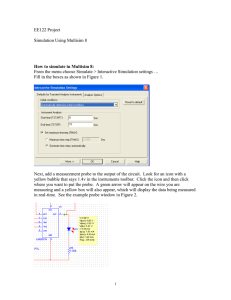
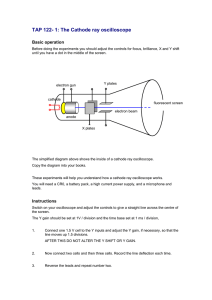
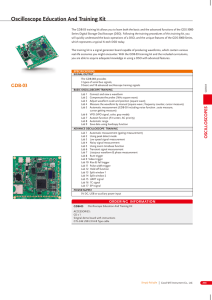
![Quality Improvement Plan Review Checklist: [CHB Name] On Which Page(s) Not Found](http://s2.studylib.net/store/data/015054359_1-99efdb5322734cfdc03b7d747179bffd-300x300.png)
